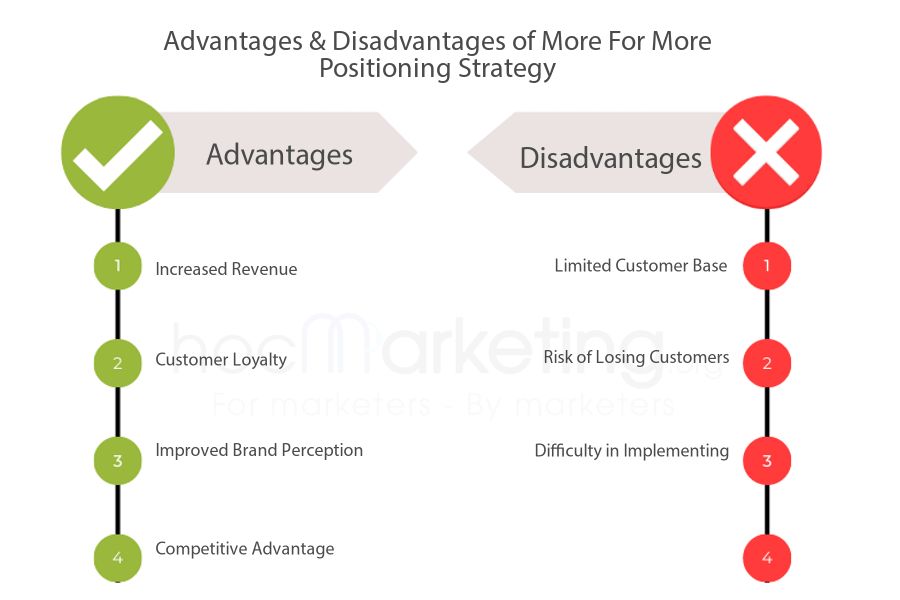
What is More For More Positioning Strategy? Advantages and disadvantages

Learn about the advantages and disadvantages of More For More Positioning Strategy. Discover how this approach can boost revenue, build customer loyalty, and more. Examples included.
More for more positioning strategy is a marketing technique that businesses use to target high-end consumers by offering premium products or services with higher prices. This approach aims to increase revenue by appealing to customers who are willing to pay a premium for quality. However, this strategy also has its drawbacks, including the risk of losing customers and difficulty in implementation. In this blog post, we will delve into the advantages and disadvantages of using more for more positioning strategy and provide examples of companies that have successfully implemented this approach.
1. Definition of More For More Positioning Strategy
More For More Positioning Strategy is a marketing technique in which a company offers high-quality products or services at a higher price to a specific target market. The emphasis is on providing more value to customers in exchange for a higher price. The goal of this strategy is to increase revenue and establish a competitive advantage in the market. This strategy is commonly used by luxury brands, high-end restaurants, and exclusive resorts. In the following sections, we will discuss the advantages and disadvantages of More For More Positioning Strategy, as well as provide examples of companies that have successfully implemented this technique.
2. Advantages of More For More Positioning Strategy
More For More Positioning Strategy is a marketing approach that targets customers who are willing to pay a premium price for high-quality products or services. This strategy involves offering superior value to customers by providing them with better quality, exclusive features, and exceptional customer service. In this section, we will discuss the advantages of More For More Positioning Strategy.
One of the key advantages of More For More Positioning Strategy is increased revenue. By offering premium products or services, businesses can charge a higher price, which can lead to higher profit margins. This approach is particularly effective in niche markets where customers are willing to pay a premium price for unique and high-quality products or services.
Another advantage of More For More Positioning Strategy is customer loyalty. When businesses provide superior value to their customers, they are more likely to develop a loyal customer base. Loyal customers are more likely to make repeat purchases, refer others to the business, and leave positive reviews. This can ultimately lead to increased revenue and a stronger brand reputation.
Improved brand perception is another advantage of More For More Positioning Strategy. By offering premium products or services, businesses can position themselves as a high-quality and premium brand. This can improve brand perception and attract customers who are willing to pay a premium price for quality products or services.
Finally, More For More Positioning Strategy can provide a competitive advantage. When businesses offer superior value to their customers, they can differentiate themselves from their competitors. This can ultimately lead to a competitive advantage, as customers are more likely to choose a brand that offers superior value and quality.
Increased Revenue
Implementing a More For More positioning strategy can have several advantages for businesses. One of the main benefits is the potential for increased revenue. By offering premium products or services at a higher price point, businesses can attract customers who are willing to pay more for a superior experience. This can lead to higher profit margins and overall revenue growth.
Additionally, a More For More strategy can help businesses target a specific segment of customers who are willing to pay more for quality. This can lead to a more loyal customer base as these customers are less likely to switch to a competitor offering lower prices. By providing a premium experience, businesses can build a strong relationship with their customers, increasing the likelihood of repeat purchases and long-term loyalty.
Furthermore, implementing a More For More strategy can improve the overall perception of a brand. By offering premium products or services, businesses can differentiate themselves from competitors and position themselves as a leader in their industry. This can lead to increased brand awareness and a stronger reputation, which can attract new customers and further drive revenue growth.
Overall, implementing a More For More positioning strategy can have several advantages for businesses, including increased revenue, customer loyalty, and improved brand perception. However, there are also potential disadvantages to consider, such as a limited customer base and the risk of losing customers who may not be willing to pay higher prices.
Customer Loyalty
One of the key advantages of the More For More positioning strategy is the potential to increase customer loyalty. By offering high-quality products or services at a premium price point, businesses can attract customers who are willing to pay more for a superior experience. These customers are often more loyal and less likely to switch to a competitor, as they have invested more in the brand and have higher expectations for the level of service they receive.
Additionally, the More For More strategy can help create a sense of exclusivity around a brand, which can further increase customer loyalty. By positioning themselves as a premium provider, businesses can tap into the human desire for status and recognition, which can lead customers to feel a sense of pride in being associated with the brand. This can make it more difficult for competitors to poach these customers, as they are emotionally invested in the brand and may be less likely to switch even if offered a lower price point.
Overall, customer loyalty is a critical component of the More For More strategy, as it can help businesses build a sustainable customer base and increase revenue over time. However, it is important to note that this loyalty is not guaranteed and must be earned through consistent delivery of high-quality products and services. In the next section, we will explore some of the potential disadvantages of the More For More strategy, including the risk of losing customers and the difficulty in implementing this approach effectively.
Improved Brand Perception
More For More Positioning Strategy can improve brand perception by offering high-quality products or services at a higher price point. By implementing this strategy, companies can establish themselves as premium brands that offer superior value to their customers. This can help to differentiate their products from those of their competitors and create a perception of exclusivity and luxury. Additionally, by offering premium products or services, companies can attract customers who are willing to pay a premium for quality, which can further enhance their brand reputation. In the next section, we will explore the advantages of More For More Positioning Strategy in more detail.
Competitive Advantage
A key advantage of implementing a More For More positioning strategy is the competitive advantage it provides. Companies that successfully execute this strategy are able to differentiate themselves from their competitors by offering higher quality products or services, more extensive features or benefits, or a combination of both. This allows them to position themselves as premium brands and charge higher prices, while still retaining a loyal customer base. Additionally, a More For More strategy can help companies establish a reputation for excellence, which can attract new customers and increase market share. Overall, the competitive advantage of a More For More strategy can help companies achieve sustained growth and profitability in the long term.
3. Disadvantages of More For More Positioning Strategy
Implementing a More For More Positioning Strategy may not always be a smooth ride as it comes with its own set of disadvantages. One of the biggest drawbacks of this strategy is that it could limit the customer base. Not all customers are willing to pay a premium price for a product or service, and this pricing strategy could deter price-sensitive customers from making a purchase.
Another disadvantage of this strategy is the risk of losing customers. If a company increases its prices without providing additional value, it could lead to customers switching to competitors who offer similar products or services at a lower price. This could result in a loss of market share and revenue for the company.
Implementing a More For More Positioning Strategy could also be difficult, especially for companies that are not well-established or do not have a strong brand image. It requires a significant investment in marketing and advertising to create awareness and convince customers of the value proposition. Companies may also have to invest in product development and innovation to justify the premium price.
Despite these challenges, companies have successfully implemented a More For More Positioning Strategy. For instance, luxury brands such as Louis Vuitton and Gucci have been able to command premium prices for their products by creating a perception of exclusivity and luxury. These brands have a loyal customer base that is willing to pay a premium for their products, which has allowed them to maintain their competitive advantage in the market.
Limited Customer Base
One major disadvantage of implementing a More For More positioning strategy is that it may limit the customer base. By offering premium products or services at a higher price point, the company is targeting a specific segment of customers who are willing and able to pay more for higher quality or exclusive features. This may exclude potential customers who cannot afford or do not value the premium offerings.
Moreover, the limited customer base may not generate enough revenue to sustain the business in the long run. The company may need to constantly innovate and invest in research and development to maintain its premium position and retain its existing customer base. This can be challenging, especially in a highly competitive market where competitors may offer similar or even better premium products or services.
To mitigate the risk of a limited customer base, companies can consider offering a tiered pricing strategy that caters to different segments of customers. This allows them to capture a wider customer base while still maintaining their premium position. Additionally, companies can also consider implementing a More For Less or Less For Much Less positioning strategy to target price-sensitive customers or those who are willing to compromise on quality or features.
Risk of Losing Customers
Implementing a More For More positioning strategy comes with risks that businesses need to consider. One of the most significant risks is losing customers. When a company increases its prices, some customers may look for more affordable alternatives. This is especially true if the company's product or service is not unique and customers have several other options to choose from.
Another reason why a company might lose customers is because of the perception that they are being taken advantage of. If customers feel like they are being charged more just because the company thinks they can afford it, they may become resentful and look for alternatives. This can damage the company's reputation and make it harder to attract new customers.
Businesses also need to consider the impact of a More For More strategy on their existing customer base. If a company has a loyal customer base that is used to paying a certain price for their products or services, a sudden increase in prices may lead to a backlash. These customers may feel like they are being punished for their loyalty and may look for alternatives.
Overall, while a More For More strategy can be effective in increasing revenue and improving brand perception, companies need to be aware of the risks involved. Losing customers can have a significant impact on the bottom line, and businesses need to carefully consider whether the benefits of a More For More strategy outweigh the risks.
Difficulty in Implementing
Implementing a More For More positioning strategy can be challenging for businesses. One of the main difficulties associated with this strategy is the need for businesses to differentiate their products or services from their competitors. This requires significant investment in research and development, marketing, and sales efforts to ensure that customers perceive their products or services as superior to those of their competitors. Additionally, businesses must be able to sustain the quality of their products or services to justify the higher price point.
Another challenge businesses face is identifying their target market. More For More strategies are typically aimed at high-end customers who are willing to pay a premium price for products or services. However, businesses must also ensure that they are not alienating their existing customer base by pricing them out of the market. This can be a delicate balancing act that requires careful consideration of pricing, marketing, and sales strategies.
Finally, businesses must be able to sustain their More For More positioning strategy over the long term. This requires ongoing investment in research and development, marketing, and sales efforts to ensure that their products or services remain competitive and that they continue to meet the needs of their target market. Additionally, businesses must be able to adapt to changing market conditions and customer preferences to ensure that their More For More strategy remains relevant and effective.
4. Examples of More For More Positioning Strategy
More for more positioning strategy is commonly used by businesses to increase their revenue by offering premium products or services at high prices. Some examples of this strategy include luxury car brands like Mercedes Benz or high-end clothing brands like Gucci. These companies offer high-quality products at premium prices, targeting consumers who are willing to pay more for better quality and exclusivity. Another example is Apple, which offers products with advanced features and innovative design, positioning themselves as a premium brand in the tech industry.
In the hospitality industry, luxury hotels like the Four Seasons or the Ritz Carlton offer high-end accommodations and personalized services to attract affluent customers who are willing to spend more for exceptional experiences. Similarly, airlines like Emirates or Singapore Airlines provide luxurious amenities and top-notch services to differentiate themselves from other airlines and attract premium customers.
More for more positioning strategy can also be seen in the food industry, where high-end restaurants like Nobu or The French Laundry offer gourmet cuisine and exceptional dining experiences at premium prices. These restaurants target customers looking for unique and memorable dining experiences and are willing to pay more for them.
Overall, more for more positioning strategy can be seen across various industries and can be a successful way for businesses to increase their revenue by targeting affluent customers who are willing to pay more for exclusive and high-quality products or services.
Summary
In conclusion, the More For More positioning strategy can be a powerful tool for companies looking to increase their market share and revenue. However, it is not without its drawbacks, such as the potential for increased competition and the risk of alienating certain customer segments. Ultimately, the decision to implement a More For More strategy should be carefully considered and based on the specific needs and goals of the company. By weighing the advantages and disadvantages, businesses can make an informed decision and set themselves up for success in the long term.















